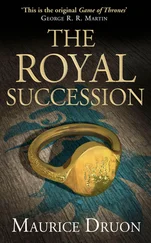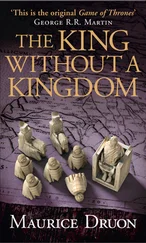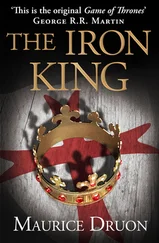All the above are historical names, as are those of the barons, justiciars, chamberlains, members of the Council, chancellors, the Abbot of Saint-Denis and the great officers of the Crown; all these people really existed. The only imaginary names are those of a few extras, of whom no trace can be found, such as Robert of Artois’s servant and the Provost of Montfort-I’Amaury.
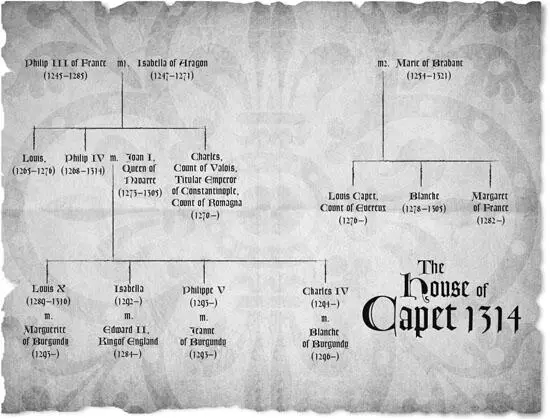
ON the 29th November 1314, two hours after vespers, twenty-four couriers, all dressed in black and wearing the emblems of France, passed out of the gate of the Château of Fontainebleu at full gallop and disappeared into the forest. The roads were covered with snow; the sky was more sombre than the earth; darkness had fallen, or rather it had remained constant since the evening before.
The twenty-four couriers would have no rest before morning, and would gallop onwards all next day, all the following days, some towards Flanders, some towards Angoumois and Guyenne, some towards Dole in the Comté, some towards Rennes and Nantes, some towards Toulouse, some towards Lyons, Aigues-Mortes and Marseilles, awakening bailiffs, provosts and seneschals, to announce in town and village throughout the kingdom that King Philip IV, called the Fair, was dead.
All along the roads the knell tolled out in dark steeples, a wave of sonorous, sinister sound spreading ever further till it reached all the frontiers of the kingdom.
After twenty-nine years of stern rule, the Iron King was dead of a cerebral haemorrhage at the age of forty-six. It had occurred during an eclipse of the sun, which had spread a deep shadow over the land of France.
Thus, for the third time, the curse laid eight months earlier by the Grand Master of the Templars from the middle of a flaming pyre was fulfilled. fn1
King Philip, stern, haughty, intelligent and secretive, had reigned with such competence and so dominated his period that, upon this evening, it seemed that the heart of the kingdom had ceased to beat.
But nations never die of the death of a man, however great he may have been; their birth and their death derive from other causes.
The name of Philip the Fair would glow down the centuries only by the flicker of the faggots he had lighted beneath his enemies and the glitter of the gold he had seized. It would quickly be forgotten that he had curbed the powerful, maintained peace in so far as it was possible, reformed the law, constructed fortresses that the land might be cultivated in their shelter, united provinces, convoked assemblies of the middle class so that it might speak its mind, and watched unremittingly over the independence of France.
Hardly had his hands grown cold, hardly had the great power of his will become extinguished, than private interest, disappointed ambition, and the thirst for honours and wealth began to proclaim their presence.
Two parties were in opposition, battling mercilessly for power: on the one hand, the clan of the reactionary Barons, at its head the Count of Valois, titular Emperor of Constantinople and brother of Philip the Fair; on the other, the clan of the high administration, at its head Enguerrand de Marigny, first Minister and Coadjutor of the dead king.
A strong king had been required to avoid or hold in balance the conflict which had been incubating for many months. And now the twenty-five-year-old prince, Monseigneur Louis, already King of Navarre, who was succeeding to the throne, seemed ill-endowed for sovereignty; his reputation was that, merely, of a cuckolded husband and whatever could be learned from his melancholy nickname of The Hutin, The Headstrong.
His wife, Marguerite of Burgundy, the eldest of the Princesses of the Tower of Nesle, had been imprisoned for adultery, and her life was, curiously enough, to be a stake in the interplay of the rival factions.
But the cost of faction, as always, was to be the misery of the poor, of those who lacked even the dreams of ambition. Moreover, the winter of 1314–15 was one of famine.
PART ONE
THE DAWN OF A REIGN

1
The Prisoners of Château-Gaillard

BUILT SIX HUNDRED FEET up upon a chalky spur above the town of Petit-Andelys, Château-Gaillard both commanded and dominated the whole of Upper Normandy.
At this point the river Seine describes a large loop through rich pastures; Château-Gaillard held watch and ward above the river for twenty miles up and down stream.
Today the ruins of this formidable citadel can still startle the eye and defy the imagination. With the Krak des Chevaliers in the Lebanon, and the towers of Roumeli-Hissar on the Bosphorus, it remains one of the most imposing relics of the military architecture of the Middle Ages.
Before these monuments, constructed to make conquest good or threaten empire, the imagination is obsessed by the men, separated from us by no more than fifteen or twenty generations, who built them, used them, lived in them, and sacked them.
At the period of this story, Château-Gaillard was no more than a hundred and twenty years old. Richard Cœur-de-Lion had built it in two years, in defiance of treaties, to defy the King of France. Seeing it finished, standing high upon its cliff, its freshly hewn stone white upon its two curtain walls, its outer works well advanced, its portcullises, battlements, thirteen towers, and huge, two-storied keep, he had cried: ‘Oh, what a gallant [ gaillard ] castle!’
Ten years later Philip Augustus took it from him, together with the whole land of Normandy.
Since then Château-Gaillard had no longer served a military purpose and had become a royal prison.
Important state criminals were confined there, prisoners whom the King wished to preserve alive but incarcerate for life. Whoever crossed the drawbridge of Château-Gaillard had little chance of ever re-entering the world.
By day crows croaked upon its roofs; by night wolves howled beneath its walls. The only exercise permitted the prisoners was to walk to the chapel to hear Mass and return to their tower to await death.
Upon this last morning of November 1314, Château-Gaillard, its ramparts and its garrison of archers were employed merely in guarding two women, one of twenty-one years of age, the other of eighteen, Marguerite and Blanche of Burgundy, two cousins, both married to sons of Philip the Fair, convicted of adultery with two young equerries and condemned to life-imprisonment as the result of the most resounding scandal that had ever burst upon the Court of France. 1 fn2
The chapel was inside the inner curtain wall. It was built against the natural rock; its interior was dark and cold; the walls had few openings and were unadorned.
Before the choir were placed three seats only: two on the left for the Princesses, one on the right for the Captain of the Fortress.
At the rear of the chapel the men-at-arms stood in their ranks, manifesting an air of boredom similar to the one they wore when engaged upon the fatigue of foraging.
‘My brothers,’ said the Chaplain, ‘today we must pray with peculiar fervour and solemnity.’
He cleared his throat and hesitated a moment, as if concerned at the importance of what he had to announce.
‘The Lord God has called to himself the soul of our much-beloved King Philip,’ he went on. ‘This is a profound tragedy for the whole kingdom.’
Читать дальше
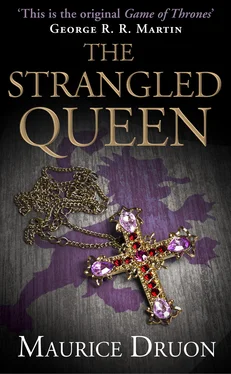





![Джеймс Чейз - Not Safe to Be Free [= The Case of the Strangled Starlet]](/books/417649/dzhejms-chejz-not-safe-to-be-free-the-case-of-the-thumb.webp)


